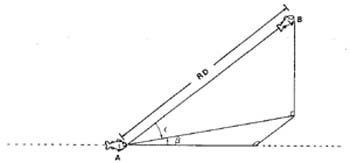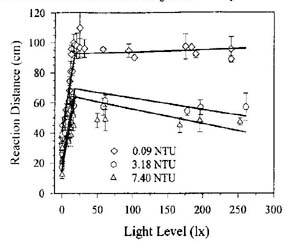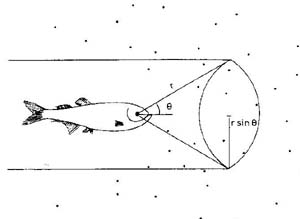Light characteristics under water
also significantly effect fish bioenergetics. This is largely related to how
these characteristics impact a fish's ability to see, so the concept of reaction
distance becomes important here. Reaction distance (RD) is the distance from
a fish that a prey item is first detected, demonstrated in the figure below.
The greater the reaction distance, the better the probability of capture,
and thus the greater efficiency in gaining energy. Therefore, light intensity
and other optical properties in the water can ultimately effect the energy
intake rate of fish. Light intensity can be related to both the time of day
and the amount of shading around a stream. Once light does reach the water,
clarity becomes a critical issue. The amount of fine and coarse particulate
matter in the water, referred to as turbidity, will effect clarity
by both absorbing and refracting light. An increase in turbidity makes it
much more difficult to see, reducing reaction distance and negatively effecting
the efficiency of obtaining energy.

Figure from Dunbrack and Dill (1984)
Experimental confirmation of the
importance of light intensity and turbidity is shown in the figure below.
Reaction distance greatly increases as light intensity increases, until dropping
off slightly after a maximum beneficial level is reached. However, at constant
light levels, greater reaction distance are observed with lower levels of
turbidity, measured in NTU's.
Figure from Vogel (1999)
Another way of considering how
important visual resolution is to the energetic success of a fish is to look
at how the rate of encountering prey is affected. Encounter rate is a component
especially important for actively foraging fish, such as a bluegill cruising
in a lake. The maximum encounter rate (E) for such a fish is
E = π(rsinθ)2vN


